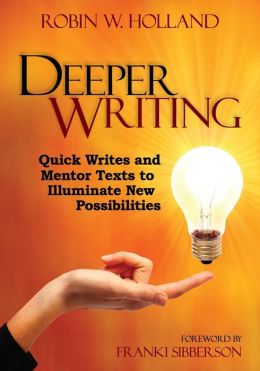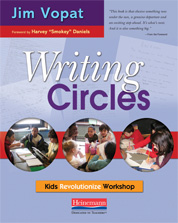How do we give helpful feedback? How do we make suggestions or give constructive criticism?
How do we tell someone what we think about their words, their writing, their exposed heart ?
There are several settings in which we may share our writing and give and receive feedback.
There are several approaches for this most delicate activity.
We can sit as partners, side by side, each sharing and responding to the other--or it may be only only one of those partners shares on a particular occasion.
We can gather in a small group of three or four or five, or not many more, to hear a chorus of responses to our work and add our own voices to the chorus for someone else.
We can gather in a large group of writers--- or an entire class-- for a read-around, for a whole group sharing.
Read-around is a strategy for sharing writing developed by Linda Christensen. You may read
more about this effective strategy in her book, Reading, Writing and Rising Up on pages 14 -15 or in her online article at Choice Literacy entitled The Read- Around: Raising Writers.
In my own classroom, we had several guidelines for large or whole group sharing that served us well:
- Time may not permit everyone to share, so if you shared the day before we asked you to wait until others have shared.
- You have the right to pass and not share.
- You have the right to receive no feedback or specify the type you would like to receive. (For example, I would like to hear only what works, or I would like to know if the setting description is enough.)
Whatever the platform for sharing and responding, it is essential to consider the words that we use to express our thoughts about the writing shared with us. We must strike a balance between approval and useless gush, between the creative tension of criticism and that fine line that crosses into cruelty, and between an intelligent intuition about useful suggestions versus controlling comments.
In the introduction to my own book, Deeper Writing on pages 10-12, I describe how early in the year, prior to our first read-around, we also began to learn language that would support our
responses, providing a scaffold for our opinions, and both guiding and guarding our responses so that we created a safe, sharing community.
I would model the use of this language extensively, and then guide
students' practice. They easily took on independent use of the language and were able to extend it to include their own language.
Helpful responses for us included:
- I like... ( words, phrases, sentences, ideas, metaphors juxtapositions, connections, strategies, etc)
- I want to hear more about...(call for more details or specificity)
- I don't understand...(call for clarity)
- I suggest...(specific suggestions for the writer with examples)
- I am wondering if...or I noticed... (general reflection)
If I were still working in my own classroom I would also add the following:
You may want to look at... (pointing to a mentor texts or other resource-- this writer, that book , this poem... or talk to this person.)
In addition, sometimes we need more information or understanding about a piece of writing before we can confidently and helpfully respond. The following questions have always
served me well in talking with writers about their writing:
- What are you trying to do?
- Why are you writing this piece?
- Who do you want to share it with? Who do you want to read it and why?
- What do you feel needs to be revised, still accomplished?
- How can I help?
During the read- arounds or other forms of sharing, students were encouraged to take brief notes so that their responses could be as specific as possible.
The student receiving feedback was the only person to write on her paper. Even in partner sharing, this was my policy.
I often encouraged the use of different colors of pencil or pen for recording feedback for possible revisions --one color for revision or notes made by the writer herself before the piece is shared, and then another color for recording notes made about comments by others while sharing.
An additional excellent resource that you may find helpful as you set up writing groups and other platforms for sharing and responding to writing is Writing Circles: Kids Revolutionize
Workshop by Jim Vopat. Not only does he share many helpful strategies for responding, but also an entire framework for establishing student-led writing groups--including information about topic selection, keeping notebooks, publishing, time management, and more.
Today's Deeper Writing Possibilities
Select a partner, small group, or whole group setting in which to share a piece of writing on which you have been working.
Before sharing, reread your own writing and consider the revisions that you think are needed.
You may want to refer to the previous related post on revision, Rewriting Texts, for suggestions.
Write a list of the revisions you are considering.
Also write a reflective paragraph about the kind of feedback you would appreciate for you piece.
After sharing, write a summary paragraph detailing the actual comments and responses you received about your writing.
What did you learn about your writing? about this specific piece? about sharing and giving and receiving feedback to writing?



No comments:
Post a Comment